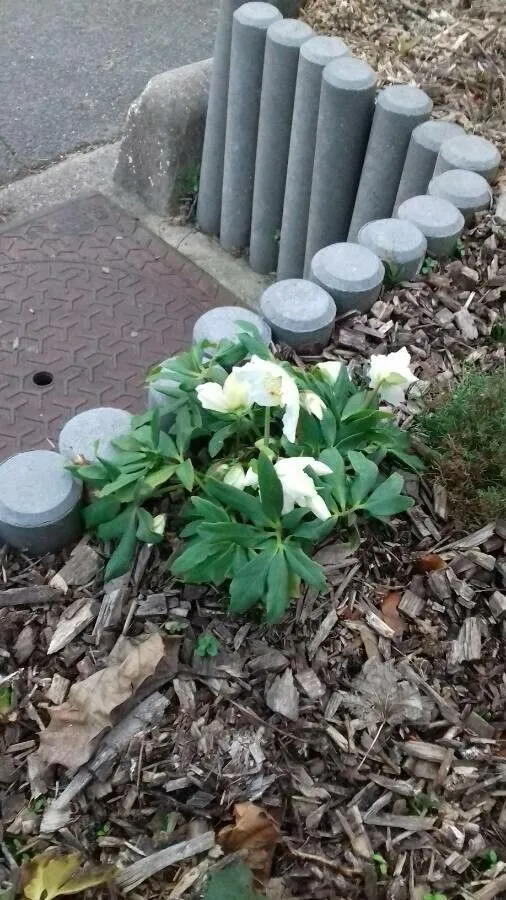
Author: L.
Bibliography: Sp. Pl.: 558 (1753)
Year: 1753
Status: accepted
Rank: species
Genus: Helleborus
Vegetable: False
Observations: Alps, Appennini
The Christmas-rose, a captivating perennial plant, is scientifically known as Helleborus niger. This enchanting plant, belonging to the Ranunculaceae family, is renowned for its striking beauty and resilience, often blooming during the cold winter months when most other flowers remain dormant.
First described by the botanist Carl Linnaeus in 1753 in his work “Species Plantarum” (Sp. Pl.: 558), Helleborus niger has since charmed botanists and gardeners alike with its unique characteristics. Originating from the picturesque regions of the Alps and the Apennines, this hardy plant thrives in mountainous terrains, embodying the serene yet formidable nature of its native habitats.
The Christmas-rose boasts dark green, leathery leaves that form a vivid contrast with its pristine, cup-shaped white flowers, which may sometimes exhibit a pinkish tinge as they age. The flowers’ prominent characteristics include a golden cluster of stamens at the center, which adds to their allure. Despite its delicate appearance, Helleborus niger is a tough plant, often pushing through snow and frost to herald the winter season with its blossoms.
Gardeners appreciate the Christmas-rose not only for its aesthetic appeal but also for its relatively low maintenance and ability to thrive in shaded garden areas. It prefers well-drained soil and can tolerate a range of conditions, making it a versatile addition to various garden landscapes. The plant typically blooms from late winter to early spring, providing a beacon of hope and beauty amidst the stark, barren winter landscape.
Beyond its horticultural charm, Helleborus niger has historical significance and has been associated with various cultural myths and medicinal uses throughout history. It was believed to have medicinal properties and was used traditionally to treat various ailments, although modern use is discouraged due to its toxic nature when ingested.
The Christmas-rose stands as a symbol of the enduring beauty of nature, resilience through adversity, and the promise of renewal. Its enduring presence and ability to bloom in the harshest of winters remind us of the subtle yet profound joys that nature can offer, even in its quietest seasons.
Dan: almindelig julerose, hvid julerose
Eng: black hellebore, christmas-rose, black helleborus, christmas rose
Deu: christrose, schwarze nieswurz, schwarze nieswurz, christrose
Fra: ellébore noir, hellébore noir, rose-de-noël, hellébore noire, rose de noël
Swe: julros
Nld: kerstroos
En: Christmas-rose, Black helleborus, Black Hellebore, Carnation, Christmas rose, Eyelet, Easter rose, Ceasterwyrt, Melampode
Ar: خربق أسود
Az: Qara şaxtagülü
Bg: Черен кукуряк
Ca: Hel·lèbor negre
Zh: 聖誕玫瑰
Kw: Kraban an ors du
Hr: Velecvjetni kukurijek
Cs: Čemeřice černá
Da: Almindelig Julerose, Hvid julerose
Nl: Kerstroos, Gewone Kerstroos
Eo: Nigra heleboro
Et: Must lumeroos
Fi: Vaaleajouluruusu
Fr: Rose de Noël, Hellébore noire, Hellébore noir, Ellébore noir, Rose-de-Noël
De: Schwarze Nieswurz, Christrose, Christblume, Weihnachtsrose, Winterrose, Schwarze Nieswurz, Christrose, Weiße Christrose
Hi: कटुकी
Hu: Fekete hunyor
It: Elleboro bianco, Rosa di Natale, Elleboro nero, Rosa-di-Natale
Ml: ഹെല്ലെബോറസ് നൈഗർ
Gv: Blaa Nollick
No: Julerose
Fa: خربق سیاه
Pl: Ciemiernik biały
Ru: Морозник чёрный
Sr: Црни кукурек
Sd: ڪٽڪي
Sk: Čemerica čierna
Es: Eléboro negro, Črni teloh, Rosa de Navidad
Sv: Julros
Tr: Noel gülü
Uk: Чорний чемерник
Cy: Pelydr Du
: Black hellebore
Taken Dec 31, 2021 by Kai Best (cc-by-sa)
Taken Jan 6, 2019 by Dieter Wagner (cc-by-sa)
Taken Jan 11, 2022 by Manuëlle (cc-by-sa)
Taken Dec 31, 2021 by Kai Best (cc-by-sa)
Taken Feb 2, 2022 by Tristan Jaton-Maria (cc-by-sa)
Taken Jan 16, 2018 by Dieter Wagner (cc-by-sa)
Taken Jan 8, 2019 by Dieter Wagner (cc-by-sa)
Taken Feb 2, 2022 by Tristan Jaton-Maria (cc-by-sa)
Taken Jan 12, 2022 by Rvt 063 (cc-by-sa)
Taken Jan 8, 2019 by Dieter Wagner (cc-by-sa)
Taken Jan 20, 2022 by Jim Knopf (cc-by-sa)
Taken Dec 26, 2020 by Dieter Wagner (cc-by-sa)
Taken Feb 26, 2022 by Annemarie Ahrens-Stehle (cc-by-sa)
Taken Feb 11, 2021 by Dieter Wagner (cc-by-sa)
Taken Feb 9, 2022 by huy HO (cc-by-sa)
Taken Jan 14, 2022 by Fabrice Rubio (cc-by-sa)
Taken Dec 11, 2018 by Dieter Wagner (cc-by-sa)
Taken Jan 11, 2022 by Manuëlle (cc-by-sa)
Taken Mar 13, 2019 by Dieter Wagner (cc-by-sa)
Taken Feb 2, 2022 by Tristan Jaton-Maria (cc-by-sa)
Taken Mar 12, 2022 by Dieter Albrecht (cc-by-sa)
Taken Mar 19, 2020 by agnieszka (cc-by-sa)
Taken Feb 1, 2021 by Belloni Paolo (cc-by-sa)
Taken Feb 3, 2020 by Dieter Albrecht (cc-by-sa)
Taken Jan 3, 2022 by Irmgard Groß (cc-by-sa)
Taken Feb 3, 2020 by Dieter Albrecht (cc-by-sa)
Taken Jan 11, 2018 by Christophe Cordier (cc-by-sa)
Taken Dec 15, 2018 by Dieter Wagner (cc-by-sa)
Taken Nov 26, 2022 by Uta Groger (cc-by-sa)
Taken Jan 16, 2017 by Marlu (cc-by-sa)
© copyright of the Board of Trustees of the Royal Botanic Gardens, Kew.
© copyright of the Board of Trustees of the Royal Botanic Gardens, Kew.
Growth habit: Forb/herb
Ph maximum: 8.0
Ph minimum: 7.5
Light: 5
Atmospheric humidity: 5
Bloom months: [‘jan’, ‘feb’, ‘mar’, ‘apr’]
Soil nutriments: 4
Family: Myrtaceae Author: (F.Muell.) K.D.Hill & L.A.S.Johnson Bibliography: Telopea 6: 402 (1995) Year: 1995 Status:…
Family: Rubiaceae Author: Pierre ex A.Froehner Bibliography: Notizbl. Bot. Gart. Berlin-Dahlem 1: 237 (1897) Year:…
Family: Sapindaceae Author: Koidz. Bibliography: J. Coll. Sci. Imp. Univ. Tokyo 32(1): 38 (1911) Year:…
Family: Asteraceae Author: A.Gray Bibliography: Pacif. Railr. Rep.: 107 (1857) Year: 1857 Status: accepted Rank:…
Family: Fabaceae Author: Medik. Bibliography: Vorles. Churpfälz. Phys.-Ökon. Ges. 2: 398 (1787) Year: 1787 Status:…
Family: Aspleniaceae Author: (Cav.) Alston Bibliography: Bull. Misc. Inform. Kew 1932: 309 (1932) Year: 1932…